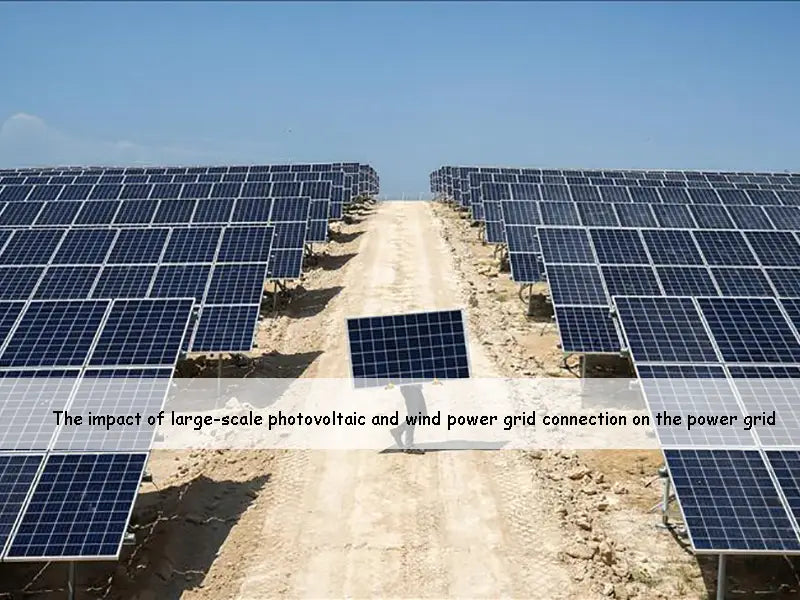
Main content:
Firstly, the characteristics of solar energy resources in Qinghai are analyzed, and according to the measured data of light and temperature in Golmud, the proposed photovoltaic power plants site in Qinghai Province in 2008, the output of photovoltaic power plants and its variation characteristics are studied, and the probability distribution of its output is statistically analyzed; The load data of the power grid is used to discuss the correlation between the output of photovoltaic power plants and the load changes of Qinghai power grid.
1. Analysis of the characteristics of solar energy resources of photovoltaic power plants
(1) Irradiation analysis in Qinghai Province. Qinghai Province is located in the northeastern part of the Qinghai-Tibet Plateau, between 89°35′-103°04′ east longitude and 31°39′-39°19′ east longitude. Adjacent to Gansu, Sichuan, Tibet and Xinjiang, it is the link connecting Tibet, Xinjiang and the mainland. The landforms of Qinghai Province are complex and diverse, and more than four-fifths of the area is plateau. The east is mountainous and the altitude is lower, the west is plateau and basin, the average altitude of the whole province is above 3000.
Qinghai Province is located in the middle latitudes, where the intensity of solar radiation is high and the illumination time is long. Among them, the direct radiation amount accounts for more than 60% of the total radiation amount, ranking second in the country after Tibet. The spatial distribution of total radiation in Qinghai Province is characterized by more in the northwest and less in the southeast. The areas with particularly rich solar resources are located in the Qaidam Basin and the southern Tanggula Mountains; the areas with rich solar resources are located in Hainan, Haibei, Maduo and Maqin in Guoluo Prefecture. , Yushu and the northern part of Tanggula Mountain; areas with abundant solar energy resources are mainly distributed in Menyuan, eastern agricultural areas, Huangnan Prefecture, and southern Guoluo Prefecture in Haibei. Xining City and Haidong area.
The average altitude of the Haixi area of Qinghai is above 3000m, the atmosphere is thin and clean, with good transparency, low latitude, and long sunshine time.
Golmud is located in the hinterland of the Qinghai-Tibet Plateau, on the alluvial plain of the Golmud River in the central and southern part of the Qaidam Basin in Qinghai, with an average elevation of 2780m. The Qaidam Basin is one of the regions with the most abundant radiation resources in my country. The total annual solar radiation is between 6618.3 and 7356.9 MJ/m2, which is higher than that in the eastern part of my country at the same latitude. The spatial distribution of solar radiation resources gradually decreases from west to east. The total solar radiation in various places generally exceeds 6800MJ/m2, the highest is 7356MJ/m2, and the average annual total solar radiation is 7000MJ/m2. There are many sunny days in the Qaidam Basin, the utilization period is long, and the annual sunshine hours are more than 3000h. The area with the longest sunshine hours is also the area with the largest percentage of sunshine in Qinghai Province. The average daily sunshine time in Golmud is close to 8.5h, the annual average sunshine hours is 3096.3h, and the annual total solar radiation is 6600~7100MJ/m2. It is one of the areas with rich solar energy resources in the Qaidam Basin. The picture below shows the Datang Golmud photovoltaic power plant.
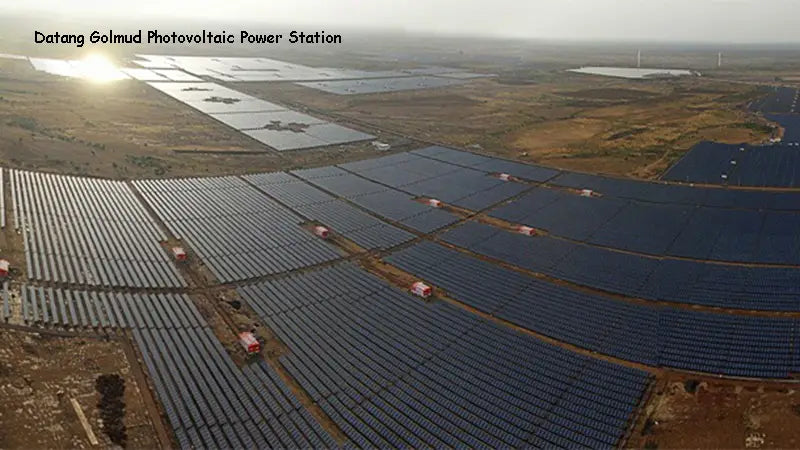
(2) Analysis of irradiation data in Golmud area. The planned photovoltaic power plants site area of Qinghai Province is located in the suburb of East Exit of Golmud City. The weather station closest to the site and the Golmud weather station are selected as the meteorological data collection point. 30km, although Golmud City has developed rapidly in recent years, and the urban population has increased a lot, but due to the small overall scale of the city, the urbanization characteristics are not obvious. Therefore, the local microclimate change brought about by urbanization has little effect on solar radiation. The climate environment of the Golmud Meteorological Station and the planned photovoltaic power plants site are basically the same. Located within the city area of Golmud, it belongs to the same climatic zone, and the climate environment is consistent. The solar altitude angle, atmospheric transparency, geographic latitude, sunshine hours and altitude of the two places are very close. Therefore, the study selects the Golmud meteorological station as the meteorological data collection station for solar radiation research, and uses the solar radiation data of this station as the basis for the processing and research of photovoltaic power plants.
2. Analysis of output characteristics of photovoltaic power plants
According to irradiance data, temperature data, sun position model and photovoltaic cell model, the output of photovoltaic power plants can be calculated. The output characteristics of a 250MW installed photovoltaic power plants will be analyzed below. The typical sunny day output curve is shown in Figure 10-2. It can be seen from the figure that the processing shape of the photovoltaic power plants in sunny weather is similar to half sine wave, which is very smooth. The output time is concentrated between 6:00 and 18:00, and reaches the maximum at noon. In cloudy weather, due to the occlusion of clouds, the radiation Illumination data changes greatly, resulting in large short-term fluctuations in the output of photovoltaic power plants.
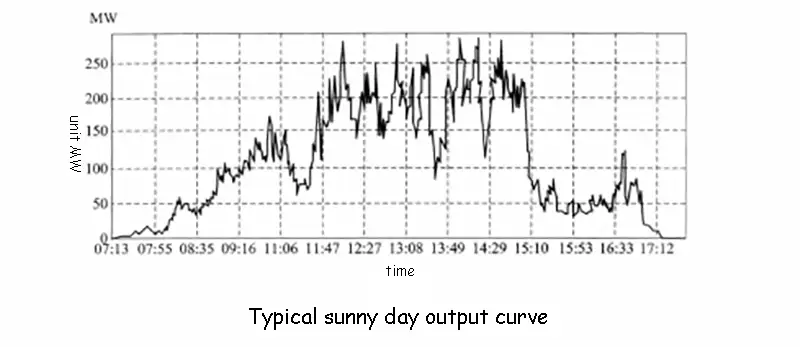
The daily on-off time of the photovoltaic power plants. Assuming that the irradiance is greater than 120W/m2, the photovoltaic power plants start to output. The daily output time of the photovoltaic power plants are concentrated at 7:00-20:00. The output time is short in winter and long in summer. The maximum output time is 14:00 noon in Beijing. time) or so.
3. Correlation analysis of photovoltaic power plants output and load change
(1) The relationship between the annual output of photovoltaic power plants and the annual load. The correlation between the output of photovoltaic power plants on the photovoltaic grid and the load changes is not strong. In some months, the output of photovoltaic power plants is opposite to the load changes, which increases the peak-to-valley difference of the equivalent load in the grid. The maximum output and load of a photovoltaic power plants depend on the location of the power station, the location of the user and the local economic development.
In 2008, due to the impact of the financial crisis, industrial power consumption was greatly reduced, resulting in a trough in winter load, and the results of years of operation show that Qinghai Power Grid belongs to the peak load period in winter. The correlation of changes is not strong.
(2) The correlation between the output of photovoltaic power plants and daily load changes. The correlation between the annual average photovoltaic power plants output and load changes has been analyzed in the previous section, and a macro concept is given. The daily variation characteristics of the output and load of photovoltaic power plants have more practical application significance, and have certain reference value for the arrangement of other power supply scheduling curves.
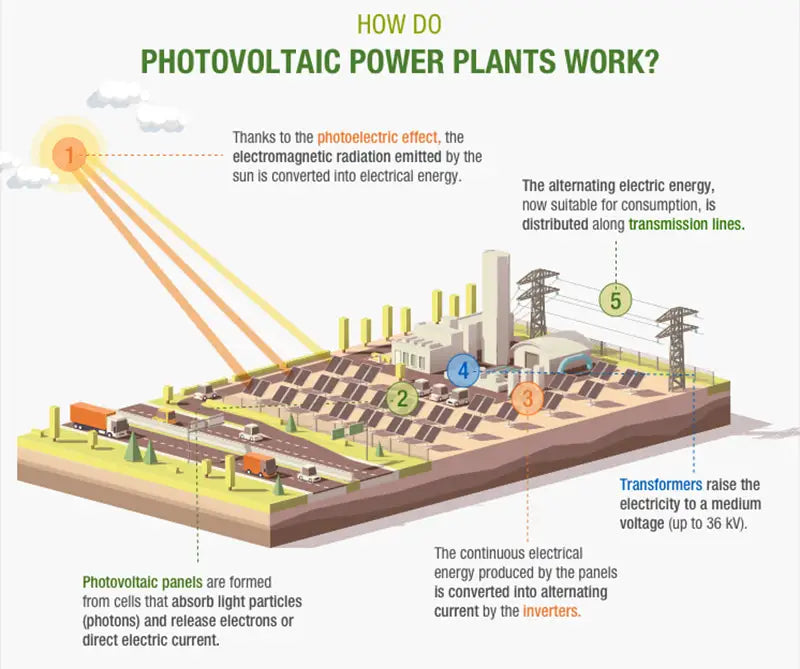
(3) Conclusions and suggestions for the proposed construction of photovoltaic power plants
①Qinghai Province is very rich in solar energy resources. The planned photovoltaic power plants site is located in Golmud area, and the annual sunshine hours are more than 3000h. Because the Golmud meteorological station is very close to the planned photovoltaic power plants site, and the climate environment is basically the same, the solar altitude angle, atmospheric transparency, geographical latitude, sunshine hours and altitude of the two places are very close. Therefore, the Golmud meteorological station is selected as the meteorological data collection station for solar radiation research, and the solar radiation data of this station is used as the basis for the output research of photovoltaic power plants.
②The total irradiance on the horizontal plane in Golmud area is the highest in summer, while the direct irradiance has no obvious seasonality. Due to the good air transparency index and large scattered radiation, the solar energy resources in Golmud area are generally very good.
③The earth revolves around the sun at the same time, and the position of the sun relative to the ground plane changes all the time. The irradiance of the horizontal plane and the inclined plane is affected by the sun's declination angle, hour angle and latitude. For inclined surfaces, the angle of incidence between the solar incident ray and the normal to the inclined surface is affected by the inclined surface angle, the solar elevation angle, and the inclined surface azimuth angle.
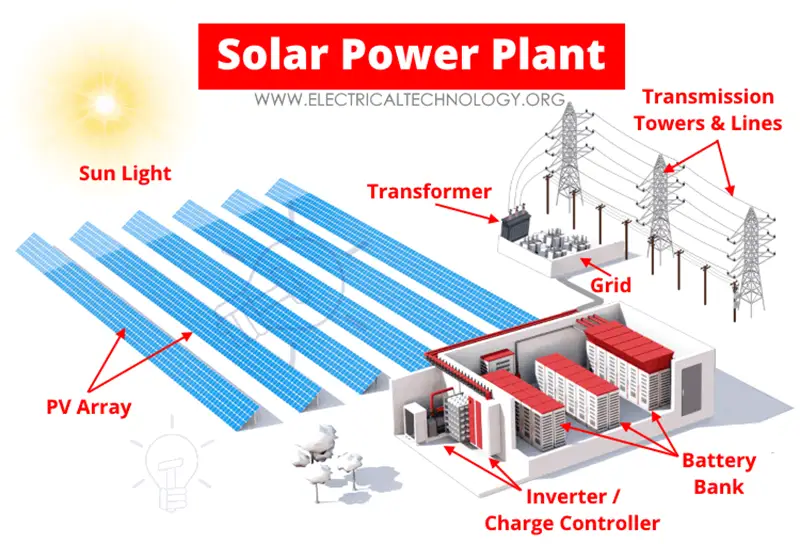
④ Photovoltaic power plants have intermittent, random and obvious periodicity. Since the output of the photovoltaic power plants are always zero at night, according to the statistics at the time of the year, the results show that less than 10% of the peak output accounts for a large proportion. The statistical results without considering the zero output at night show that the output range of the photovoltaic power plants are very wide, from 40 The probability of %-90% peak power consumption is above 10%: the maximum daily output of photovoltaic power is concentrated between 12:00 and 15:00. During this period, the cumulative probability of output exceeding 150MW reaches 60%, so at noon The output percentage of photovoltaic power plants is very high, which is determined by local solar radiation conditions; according to statistics, the number of sunny days with large output in Golmud area accounts for the majority, and the utilization rate of photovoltaic power plants is very high, and the daily output time is concentrated in 7:00~20:00 , the output time is short in winter, and the output time is long in summer. The maximum output time is about 14:00. The installation angle of the solar panels is based on the best installation angle throughout the year. The maximum daily output of photovoltaic power plants occurs in March, June, and July. Due to the heavy rain, the maximum daily output is limited, and the maximum daily output is in December and January of the following year. lowest.
⑤Due to the inherent characteristics of the grid load and the direct influence of the output of photovoltaic power plants by irradiation data, the correlation between the daily and monthly changes of the output of photovoltaic power plants and the load in Qinghai is not strong.
Read more: Overview of AC Power Distribution System of Photovoltaic Power Station